Emma quit her job as a teacher in Portugal to pursue a dream of sailing around the world, recording music in a small boat studio along the way. So far, sail yacht Bloodshot has sailed from Lisbon to Morocco, the Canaries, and across the Atlantic to the Caribbean. (Editor’s Note: this triggers my own memories of Sailing the Caribbean). This week-in-the-life documents her continued journey as the boat presses on towards the more intrepid waters of Venezuela and Colombia.
This post was originally published in 2014. It has since been updated for accuracy of links and content.
Day 1: Sunday
10am:We have decided to leave Curaçao in a generally Western direction tomorrow, so it’s off to the immigration office to check out of the country. We’ve always got one eye on the forecast, and the next few days show calm winds and small seas. A perfect time to round the notoriously rough Punta de Gallinas in Colombia on our way to San Blas. There might even be time for some Colombian exploration.
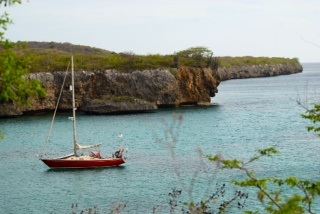
12am: Arrive immigration office. Pose for pictures being taken for the Curaçao immigration website: immigration officer is really friendly and gets the giggles when we are posing for our photos. Quick trip to the supermarket for eggs, vegetables and custard creams, in case we don’t get to a supermarket for a while. Willemstad is an interesting city. The big banqueting halls, where you can get a massive lunch for five dollars, look particularly appealing.
3pm: Lunch in KFC, which is something I’ve tried to feel guilty about, but after a few weeks of chick pea curries on the boat, I just can’t.
5pm: Back to the boat, and preparation for tomorrow’s passage; i.e. filling the fridge with sandwiches, nicely wrapped and labelled for easy scoffing during sailing. Today’s selection includes tuna, peanut butter and cherry jam, and some weird stuff called apfelstroop which Phil bought in Bonaire and looks like engine grease. It’s a short five-hour hop to a quiet anchorage at the other end of Curaçao. It’s always nice to spend a day somewhere quiet before a longer passage. After a few high-octane games of draughts, it’s early to bed after a nice cup of chamomile tea. Rock and roll!
Day 2: Monday
6am: Wake up to deceptively strong winds in Spanish Water harbour. After muesli and coffee we stop at the fuel dock to fill our water tanks. Thinking the water is free, we are dismayed when a disgruntled-looking official runs out of the office, waving his arms and shouting at us as we sail off. We can’t turn around due to the wind, so the start of our journey is marred by accidental water-theft guilt. Once out of the harbour, the wind drops, and conditions become perfect. Apart from the guilt.
12pm: Soup and sandwiches as we watch the massive cargo ships leaving the port of Willemstad and try to guess how long they are. A fun game, as you can check on the boat’s AIS system, which tracks any boats close to you and tells you their length, speed and destination. The biggest is just under a thousand feet long, and even has its own recycling bay; ironic considering it is probably burning about two thousand gallons of fuel an hour.
5pm: Delighted to arrive at the beautiful Santa Krus anchorage and have the place to ourselves. Just enough time for some snorkelling before sunset. The reefs here aren’t as pristine as in Bonaire but are still teeming with life.
Day 3: Tuesday
7am: Leisurely pancake breakfast made even tastier by the addition of our last packet of El Cort Ingles special cured bacon, purchased a lifetime ago in Portugal.
9am: Time for a snorkel. I choose to follow a pretty puffer fish as it goes about its routine of swimming and stopping at rocks for a nibble. What a simple life. Days like this make the tougher aspects of sailing around the world all seem worthwhile.
10am: Row the dinghy to shore for an explore. My attempts at rowing the dinghy in anything above a light breeze are laughable and this one is no different. Eventually after lots of shouting and rowing in circles, we make it. I sit and watch crabs dig holes and pelicans hunt fish, while Phil walks to the next town to get an up-to-date weather report for the next part of the journey. My companion is a gorgeous stray dog who stays loyally at my side all day. I try to take some arty pictures of sea urchins, so we’ll see how those turn out.
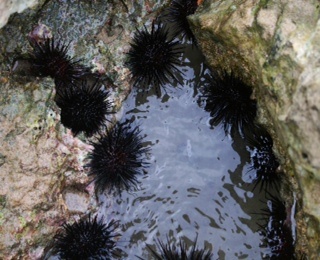
2pm: Back to the boat (Phil rows) for lunch and preparation for tomorrow’s departure. We are both a little nervous as this part of the journey is the one with a bad reputation for rough conditions. However, we have chosen a day with little wind and small seas so we are pretty confident. Preparations this time include baking two carrot cakes, slicing up another massive heap of sandwiches and rustling up a few Hawaiian pizzas: the perfect food for passages wrapped in handy “grab-a-slice” packages.
8pm: After chick pea curry we depart Santa Krus at sunset into beautiful calm seas and warm winds. Our first port of call will be the island of Los Monjes del Sur, 50km from the Colombian coast. Uninhabited apart from a couple of Venezuelan coastguards, Los Monjes is pretty much just a rock. But apparently, they have good wifi. It should take us about twenty hours to get there.
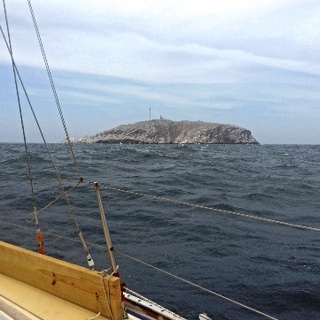
Midnight: Thunder and lightning starts. Very very frightening. Always a contentious issue amongst sailors, you never know whether to enjoy the spectacle or cower in your bunk praying that the boat doesn’t get hit and sunk. It doesn’t help that the main cabin light starts freaking out and flashing on and off by itself. I adopt my usual approach to stress (curl in foetal position, cry quietly, pass out) while Phil steels himself, in his capacity as super-human captain, through several hours of flashing purple skies and cool rains.
Day 4: Wednesday
3pm: After an exhausting night and a blissfully uneventful day’s sailing, we spy Los Monjes on the horizon. It’s a good job we are arriving during daylight as Los Monjes is actually about half a mile further north than the GPS system says it is. We are exhausted.
4pm: We are welcomed to Los Monjes by the friendliest coastguards ever. The island is tiny, with nothing on it except a lighthouse, a cabin for the coastguards, and a family of stray dogs. It takes us an hour of snorkelling and motoring back and forth to arrange our lines, so that we are securely fastened to the rope normally used by fishermen. A supplies boat arrives and the crew stop work to watch us, seemingly amused.
5pm: Later, the supplies boat unloads their delivery (potatoes) and cleans the boat. We stop to watch them. At sunset, one of the young military trainees swims over to our boat to give us some snappers they caught especially for us. Another trainee gives us a tour of the island. It doesn’t take long.
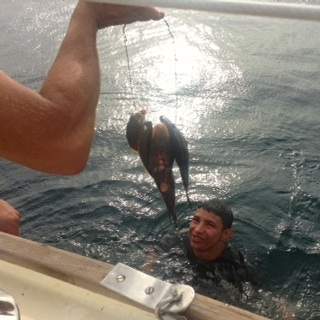
8pm: After a tasty fish dinner, Phil checks the weather and breaks the news that we will be departing at 3am in order to catch the next period of light wind, as you never know when the next one will come. After watching the sea birds coming into roost and nestling together on the cliffs, we collapse, feeling safe and full, into a deep dreamless sleep.
Day 5: Thursday
4am: Depart Los Monjes with winds light as promised, filling us with confidence about passing “Chicken Point” later today. I feel sad that we weren’t able to say goodbye to the coastguard and thank them in person. But we chat to them on the radio and they tell us to keep in touch during our journey so that they know we are safe. We are escorted away from Los Monjes by dolphins, who glow in the phosphorescence under a pitch-black sky, so that they look like dolphin ghosts.
11am: The weather is glorious and the sailing very comfortable as we approach the Colombian coast, making us glad that we took that weather window. The coast is stunning, completely virgin, so it almost seems like sailing on the sea of some distant moon.
3pm: We pass an eerie, rusted shipwreck.
4pm: Fish! We catch a huge ugly thing with a massive mouth, later identified as a great trevally. That’s food for the next three days sorted. Phil cleans it, pulls about fifty dead squid out of its belly, and fillets it.
5pm: Another yacht, Suzy Too, passes on its way back to Curaçao. We have a chat with them on the radio and they fill us in on the anchoring conditions in the bay at Cabo de la Vela, where we plan to stay the night before continuing to Santa Marta. Chicken Point lies behind us. We breathe huge sighs of relief and I feel grateful to have such a weather-savvy captain.
7pm: Unfortunately it is already dark when we start our approach into the bay. It’s easy to get relaxed too soon when arriving: in fact, the toughest part of a journey can often be arriving and tying up. We sail slowly towards the centre of the bay, unable to get our bearings in the darkness and baffled by the depth readings from the faulty depth sounder. It isn’t long before we realise we are surrounded by fishing lines, marked by barely visible buoys made out of coke bottles. We back out gingerly, bracing ourselves for the sound of the motor grinding to a halt as a fishing line wraps itself around the propellor. Luckily we avoid entanglement and manage to drop the anchor, still largely unaware of how far we are from land and whether or not we are anchored in the middle of a massive fish farm.
Day 6: Friday
7am: We awake to the stunning sights of the bay at Cabo de la Vela. The water is pristine and turquoise, whipped into small waves by constant hot, strong winds. Around us curves the same lunar-style landscape we saw on the approach, with low-lying shacks and beach cabanas, and even a few kite surfers. As the temperature climbs steadily towards 40 degrees, we decide to have a lazy day on the boat. Whatever delights await us on shore, they can wait.
11am: I polish a few winches, before deciding it is far too hot for such nonsense and collapse for an afternoon nap after a refreshing swim.
7pm: Dinner is Thai soup using a couple of the trevally fillets, which are bit like tuna but less meaty, leftover green peppers, potatoes and butternut squash; the most hardcore vegetable known to man. We revel in another “this is why we do it” moment as we scoff fresh fish under the vibrant, blood-red sunset.
Day 7: Saturday
6am: We awake to already disturbingly high temperatures and the sight of our friend Lorenzo’s boat anchored not far from us. He made the same journey as us but encountered very strong winds, only twenty four hours later than us, making for a rough passage. And he got tangled up in a fishing line on the way in. Needless to say he isn’t in the best of moods. After eight months, I’m starting to realise that, for reasons often out of your control, sailing is either really, really amazing, or really, really crap.
8am: After a leisurely breakfast (most breakfasts are leisurely nowadays; definitely one of my favourite things about not working) we blow up the dinghy, attach the motor, and buzz off into the wind towards the town. We leave the dinghy at the local kite surf school where we meet Martyn and Sophie, who have run the school for three years and employ local children to train up as instructors. They share their breakfast of Colombian arepas with us and I settle in the deckchair while Phil gets ready for his first kite surf since Bonaire.
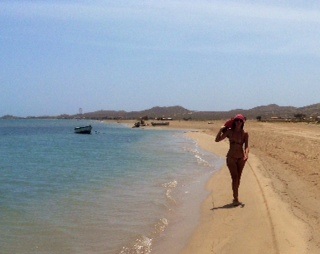
12pm: We eat lunch (pasta salad with more trevally) as we watch the comings and goings of life in Cabo de la Vela; populated by native Guajira Indians, the town is also slowly growing in popularity as a trendy holiday destination for Colombians, meaning souped-up four-wheel drives and designer bikinis can now occasionally be spotted alongside the ubiquitous stray dogs and barefoot, laughing children. One thing everyone has in common is friendliness; everyone is kind and welcoming, and keen to chat. We meet Catalina who is five and calls Phil “Phyllis”, local women crocheting beautiful mochilas, and marvel at the amazing kite skills of the local kids.
3pm: I meet Miguel, one of the kite instructors. He is a guitarist! We are going to play together tomorrow. He says he plays a lot of bossa nova. Oh, these South Americans with their effortless mastering of complex rhythmic structures. I’ll have to dig out my inner Shakira.
5pm: After a beautiful day we take the dinghy back to the boat, buzzing, sunburnt and happily exhausted. Phil dives down to unhook the anchor from a rock it’s snagged on, and I whip up a batch of peanut butter cookies, having been seized by the urge to bake; something which doesn’t happen very often. I’ve got a feeling we are going to be staying here longer than just one night…
Emma is now in Bocas del Toro, Panama, after a few blissful weeks exploring Colombia and the San Blas islands. Hopefully she will be able to find some work there, along with a good yoga teacher, and a few musicians with formidable natural rhythm. After that, who knows? The Pacific Ocean is only a canal away…
You can follow Emma at emmajayashton.com and on twitter at @emmajayashton. You can also listen to sounds she has recorded along the way at www.soundcloud.com/Emma-Jay-Ashton.

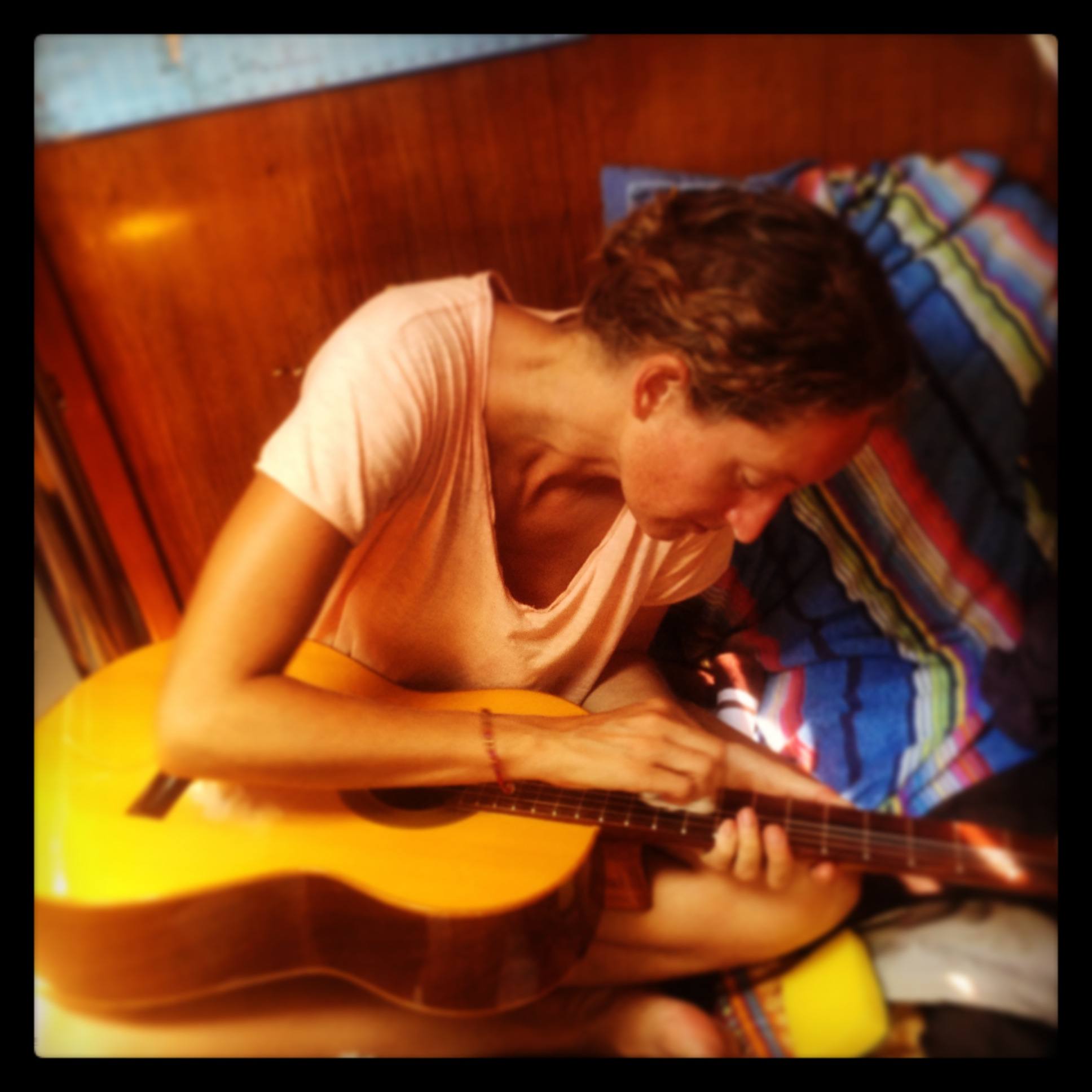

The sailing life is one that I hope to enjoy once I automate my writing business … I little too tied to the biz to make it happen right now … but it it high up on my bucket list!
Noah,
Indeed, internet access can be a fleeting thing on the high seas. But there’s often WiFi in most marinas…
Yes, there normally is… Even if you do have to stick your ipad out of a hatch and wave it around until you get a couple of bars. I find it useful to make friends with rich yachties so you can hack their super-speed internet. Noah…cut the ties! Come sailing! X